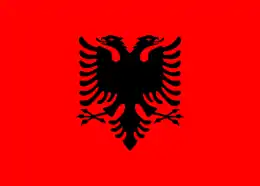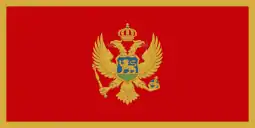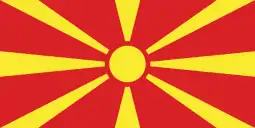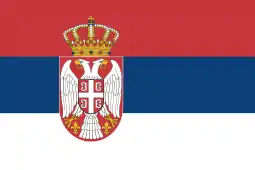Rail transportation in Kosovo
The Railways of Kosovo in station territories take place from 333.9 km (207 mi) up to 105.7 km (66 mi), whereas the industrial lines involve 103.4 km (64 mi). The Railways of Kosovo are a property of the public sector where the state has access to ruling all administrative actions in the Ministry of Economic Development.[2]
 | |
| Overview | |
|---|---|
| Headquarters | Fushë Kosovë, Kosovo |
| Locale | Kosovo |
| Dates of operation | 1874–present |
| Technical | |
| Length | 333.9 km (207.5 mi)[1] |
| Other | |
| Website | www infrakos |
History
In Kosovo, the construction of railways lines first took place in 1874 where the first railway line was built for the destination from Hani Elezit to Fushe Kosove and to Mitrovice. This was the beginning of launching the railway network around Kosovo and it became very significant for the transportation of travellers and goods. Also, it was equally important for the economic development of the country. Likewise, it enabled connectivity with other regions. With the construction of this railway line, railway transportation became amongst the busiest ones which led to opportunities for finding jobs for new railway lines. During 1934 the construction of this line proceeded in relation to a different direction such as that of Mitrovice – Leshak, in 1934 for Fushe Kosove – Prishtine, in 1936 Fushe Kosove – Peje, in 1949 Prishtina – Podujeve – Livadhi, and in 1963 Kline – Prizren.
On 27 September 1999, the Kosovo Train for Life charter train arrived in Pristina, bringing aid and rolling stock in connection with the Kosovo Force peace-keeping efforts.[3]
As of 2014, Kosovo railways stretch almost throughout the entire territory of Kosovo, with the exception of two cities – Gjilan and Gjakova.[4]
Trains


Railway transports, most importantly, are one of the safest transports in Kosovo. Infrastructures and motor vehicles are technically safer compared to other transports. Nevertheless, they are immune to tough weather conditions such as snow, rain, fog, and so forth. Additionally, railway transports are ecological as well since they are provided with fuel oil from "diesel-electric" locomotives as their primary fuel source.
In Kosovo's railways there are eight diesel locomotives and four thermo-motoric ones. They have the capability to carry 17 wagons, 16 from which are for passengers and the remaining one is for luggage. The railways of Kosovo have a significant role for the transportation of travelers and goods. In 2005, there has been an estimation of 870 travelers per day who chose trains as a transportation tool. In 2006, there has been an increase by 26.56% more than in 2005, which means that there was a growth by 1,100 travelers daily. In 2007, the number of passengers that have traveled with train in a day was 1,143 or 3.91% more than in 2006. In 2008, there was a decrease in the number of travelers by 18.77% compared to 2007. The average number of travelers per day during 2009 was 1,026 or 10.51% more than in 2008. Also, there has been an increase of travelers per day in 2010 by 1,032 or 0.61% compared to 2009.[5]
Domestic transport
Kosovo's railway transportations have the following daily schedules:
- The local train – travels every day from Peje to Prishtine and vice versa.
- The free movement train – travels from Hani I Elezit to Fushe Kosove, and from Fushe Kosove to Gracanice and vice versa. Currently, this line is out of function.
Serbian national railway company for passenger transport "Srbija voz" operates lines Kosovska Mitrovica Sever – Kraljevo and Leposavić – Kraljevo by RA2 Multiple Unit.
International transport
For international transport, Kosovo Railways have a regular daily train, that is called "The fast train". This train travels once a day from Prishtine to Skopje and vice versa.[6]
International connections and services
Kosovo railways connects Pristina with Skopje (North Macedonia) in the south, while Serbian railways connects Mitrovica with Kraljevo (Serbia) in the north. The track between Mitrovica and Fushe Kosove (west of Pristina) is currently not served by any trains.[7]
 Albania – No connection
Albania – No connection Montenegro – No connection
Montenegro – No connection North Macedonia – Open
North Macedonia – Open Serbia – Open
Serbia – Open
Statistics
| Year | Number of passengers | Revenues in EUR |
|---|---|---|
| 2013 | 276,852 | 179,515 |
| 2012 | 267,901 | 171,943 |
| 2011 | 279,330 | 193,593 |
| 2010 | 281,650 | 184,972 |
| Year | Tons of goods (Net) | Revenues in EUR |
|---|---|---|
| 2013 | 778,134 | 2,332,274 |
| 2012 | 488,539 | 1,601,675 |
| 2011 | 748,667 | 2,450,434 |
| 2010 | 877,332 | 2,864,370 |
References
- "Transporti". rks-gov.net. Retrieved 2014-03-02.
- "Kosovo aid train gets through". BBC News Online. 27 September 1999. Retrieved 17 October 2014.
- "RTK". rtklive.com. Retrieved 2014-03-02.
- "http://esk.rks-gov.net/publikimet/doc_download/1018-permbledhje-e-te-dhenave-te-transportit-dhe-telekomit-ne-kosove". esk.rks-gov.net. Retrieved 2014-03-02. External link in
|title=(help) - "Hekurudhat". kosovorailway.com. Archived from the original on 2014-02-28. Retrieved 2014-03-02.
- "Informata për Infrakos | INFRAKOS". infrakos.com. Retrieved 2014-03-02.
- http://www.trainkos.com/wp-content/uploads/2012/03/Plani-i-Biznesit-2013-Trainkos-Sh.A.pdf
External links
 Media related to Rail transport in Kosovo at Wikimedia Commons
Media related to Rail transport in Kosovo at Wikimedia Commons
